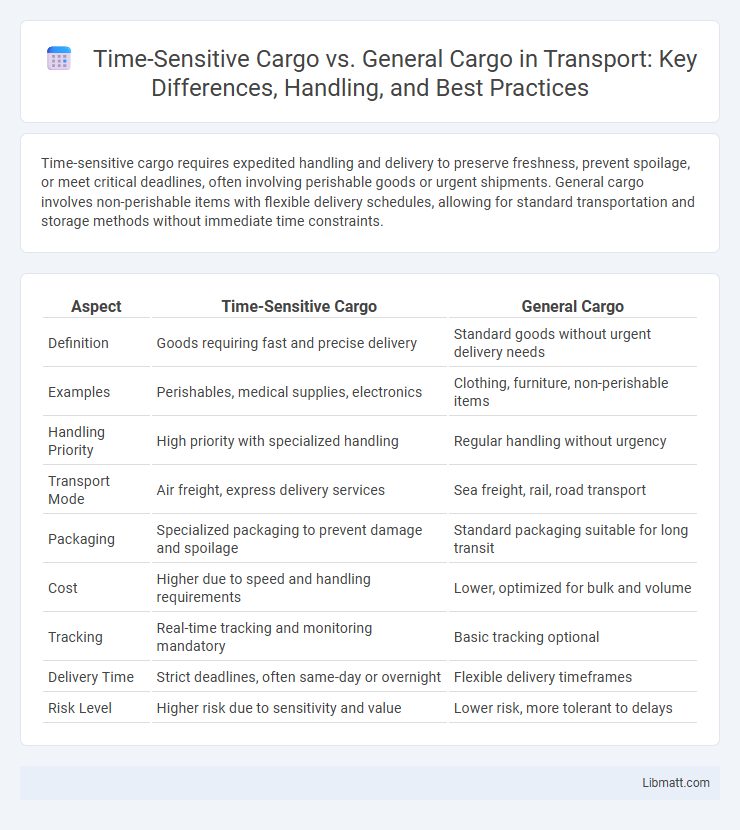Time-sensitive cargo requires expedited handling and delivery to preserve freshness, prevent spoilage, or meet critical deadlines, often involving perishable goods or urgent shipments. General cargo involves non-perishable items with flexible delivery schedules, allowing for standard transportation and storage methods without immediate time constraints.
Table of Comparison
| Aspect | Time-Sensitive Cargo | General Cargo |
|---|---|---|
| Definition | Goods requiring fast and precise delivery | Standard goods without urgent delivery needs |
| Examples | Perishables, medical supplies, electronics | Clothing, furniture, non-perishable items |
| Handling Priority | High priority with specialized handling | Regular handling without urgency |
| Transport Mode | Air freight, express delivery services | Sea freight, rail, road transport |
| Packaging | Specialized packaging to prevent damage and spoilage | Standard packaging suitable for long transit |
| Cost | Higher due to speed and handling requirements | Lower, optimized for bulk and volume |
| Tracking | Real-time tracking and monitoring mandatory | Basic tracking optional |
| Delivery Time | Strict deadlines, often same-day or overnight | Flexible delivery timeframes |
| Risk Level | Higher risk due to sensitivity and value | Lower risk, more tolerant to delays |
Understanding Time-Sensitive Cargo
Time-sensitive cargo refers to goods that require expedited handling and delivery due to strict deadlines, often including perishable items, pharmaceuticals, or urgent documents. Unlike general cargo, which has flexible transit times, time-sensitive shipments demand precise logistics coordination to maintain product integrity and meet time constraints. You must prioritize reliable transportation methods and real-time tracking to ensure these critical deliveries arrive on schedule.
Defining General Cargo: Scope and Types
General cargo encompasses a wide range of goods that are not time-sensitive, including packaged items, machinery, textiles, and electronics, typically transported in standard containers or pallets. This category excludes perishable or urgent shipments that require expedited handling, distinguishing it from time-sensitive cargo which demands priority in transit and delivery for freshness or critical deadlines. Understanding the scope and types of general cargo helps you optimize logistics planning by aligning shipment priorities and handling processes effectively.
Key Differences Between Time-Sensitive and General Cargo
Time-sensitive cargo requires expedited handling and transportation due to its perishability or critical delivery deadlines, while general cargo involves standard shipping procedures without urgent time constraints. You must prioritize temperature control, specialized packaging, and real-time tracking for time-sensitive shipments to ensure preservation and timely arrival, unlike general cargo that allows more flexible scheduling. The key differences lie in handling urgency, risk management, and logistic strategies tailored to meet strict time requirements versus routine cargo movement.
Handling and Packaging Requirements
Time-sensitive cargo demands specialized handling techniques such as temperature control, rapid transfer, and real-time tracking to maintain product integrity, while general cargo allows for standard packaging and handling procedures. Packaging for time-sensitive cargo often includes insulated containers, moisture barriers, and shock absorbers to prevent spoilage or damage during transit. In contrast, general cargo requires robust, cost-effective packaging tailored to protection against common hazards like crushing and moisture exposure without the need for advanced climate control features.
Transportation Modes: Speed versus Cost
Time-sensitive cargo prioritizes faster transportation modes such as air freight and express shipping to meet strict delivery deadlines, often incurring higher costs. General cargo typically utilizes cost-effective options like sea freight, rail, or truck transport, where longer transit times are acceptable. The choice between speed and cost reflects the urgency of the shipment and budget constraints in supply chain management.
Risk Factors and Mitigation Strategies
Time-sensitive cargo faces higher risk factors such as delays, spoilage, and time-dependent quality degradation compared to general cargo, which primarily encounters standard risks like damage or loss during transit. Mitigation strategies for time-sensitive shipments include employing advanced tracking technologies, choosing expedited transport modes, and implementing temperature-controlled packaging to preserve product integrity. You can reduce potential disruptions by integrating real-time monitoring systems and partnering with logistics providers specializing in urgent deliveries to ensure timely and secure handling of your time-sensitive cargo.
Regulatory and Compliance Considerations
Time-sensitive cargo often requires strict adherence to specific regulatory frameworks such as hazardous materials handling, temperature controls, and expedited customs clearance protocols to ensure timely delivery and safety compliance. General cargo regulations typically involve standard documentation, basic security screenings, and routine customs procedures without the urgency constraints. Understanding these differences in regulatory and compliance considerations helps you tailor your logistics strategy, reducing risks and ensuring your shipments meet all legal requirements efficiently.
Technology Solutions in Cargo Management
Technology solutions in cargo management for time-sensitive cargo prioritize real-time tracking systems and IoT-enabled sensors to monitor temperature, humidity, and location, ensuring optimal conditions throughout transit. In contrast, general cargo management emphasizes automated inventory systems and optimized route planning to enhance efficiency and reduce handling times. Advanced analytics and AI-driven platforms cater to both, but the critical focus for time-sensitive shipments lies in minimizing delays and maintaining strict environmental controls.
Industry Use Cases: When to Choose Each Cargo Type
Time-sensitive cargo is crucial for industries requiring rapid delivery of perishable goods, such as pharmaceuticals, fresh food, and high-tech electronics, ensuring product integrity and reducing spoilage risk. General cargo suits sectors with less urgent delivery needs, including textiles, machinery, and durable consumer goods, where cost-effective shipping outweighs speed. Choosing between these cargo types depends on delivery deadlines, product shelf life, and the critical nature of timely arrival for maintaining supply chain efficiency.
Future Trends in Cargo Logistics
Time-sensitive cargo demands advanced tracking technologies and expedited shipping methods to meet growing customer expectations for speed and reliability. General cargo logistics will increasingly integrate AI-driven predictive analytics to optimize routes and reduce costs, enhancing overall supply chain efficiency. Your ability to leverage these future trends will be critical for staying competitive in the evolving cargo logistics landscape.
time-sensitive cargo vs general cargo Infographic

 libmatt.com
libmatt.com